It’s not possible to remember the name of every type of flowers.
With approximately 400,000 species of flowers in the world, even the most experienced horticulturists and florists can’t possibly remember the nickname or scientific classification of each species.

The best way to remember the names of flowers is to categorize them by a common similarity, such as flowers that begin with the same letter or flowers of the same color.
On the other hand, it’s also hard to find the right kind of flower for your garden.
If you’re a florist looking for a darker flower for your flower arrangement, or if you’re a keen gardener wanting to enhance your flower bed, it’s not always easy to find rare flowers such as dark purple flowers.
Whether you’re looking to expand your knowledge of flowers or if you want to create dimension to your garden, here is our list of dark purple flowers!
1. Clematis

Clematis is a popular genus of around 300 flowering plants in the buttercup family.
With so many species and hybrids, clematis flowers come in a variety of colors and patterns, including a powerful and regal dark purple variation.
Depending on the variety, clematis flowers can bloom from spring to fall, allowing for a splash of color year-round.
The best dark purple clematis variety is undoubtedly clematis ‘Jackmanii’, which blooms intensely dark purple flowers that fade into violet with time.
These flowers are fairly easy to grow and maintain. They typically prefer to grow in sunlight, though some varieties are shade-tolerant.
2. Almost Black Sweet Pea (Lathyrus Odoratus)

Contrary to popular belief, black flowers aren’t actually black. Instead, black flowers are just a very, very dark purple! The almost black sweet pea is the perfect example of this.
This Grandiflora variety produces intensely dark purple velvet-like flowers that appear, as the name suggests, almost black.
Almost black sweet peas are highly scented and make a striking statement in a flower bed or floral arrangement. They typically prefer cool moist soil and can trail or grow up vines and walls.
3. Delphinium
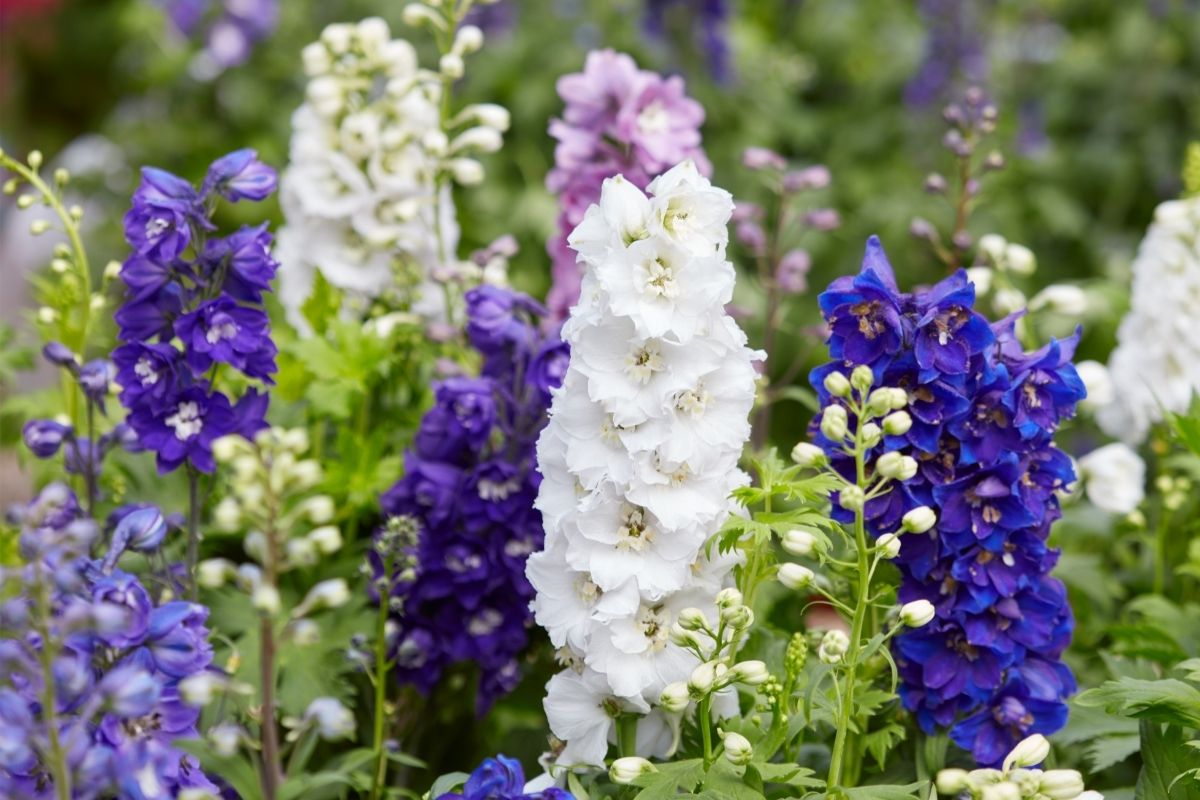
Delphiniums are a popular flowering genus native across the Northern Hemisphere. Also known as larkspur, delphiniums consist of an inflorescence of countless 5-petaled flowers.
With over 300 species in the genus, delphiniums come in a variety of colors, with the most common being shades of blue, white, and purple – including dark purple.
RELATED: Brilliant in Blue: 19 Different Types Of Delphiniums
4. Cherry Pie Plant (Heliotrope)

The cherry pie plant is a hardy flowering shrub native to Peru. These shrubby annuals are popular for their pleasant fragrance that smells like cherries and vanilla, as well as their attractive clusters of dark purple tiny flowers.
The purple color goes beautifully alongside the dark green foliage, making for a beautiful contrast in a bright garden.
Cherry pie plants are known for their erratic germination, which is why they are commonly grown in flower pots.
The plants require patience and sometimes a bit of skill, which is why they’re not ideal for beginner gardeners.
5. Petunia

Petunia is a moderately small genus of around 20 flower species native to South America.
These species and hybrids are highly popular amongst gardeners for their attractive appearance and variety of colors, including a striking dark purple variety.
There’s even a black variety, which is actually a very dark purple that appears like black velvet.
These funnel-shaped flowers bloom in summer and fall. They are fairly easy to grow, but due to their sensitivity to frost and wind, they are best grown in hanging baskets or flower pots.
6. Dwarf Iris (Iris Reticulata)

Dwarf iris, as the name suggests, is a compact and smaller version of the classic iris flower.
This species is native to Turkey and the Caucasus Mountains, and mostly comes in shades of purple or blue-purple along with a striking yellow center.
The flowers bloom in winter and early spring, allowing for a burst of color in a garden during the colder months.
As dwarf iris flowers typically only last around 3-7 days per flower, they are most commonly planted in March to symbolize the start of spring.
They work particularly well in the front of borders, in rock gardens, and underneath trees or shrubs.
7. Scottish Primrose (Primula Scotica)

The Scottish primrose, as the name suggests, is native to and found only in a small part of Northern Scotland, making it a rare species that proves to be a lovely challenge for horticulturists.
These small flowering plants produce clusters of small dark purple flowers that bear the distinctive yellow center of a primrose.
Scottish primroses aren’t the easiest species to grow in a garden as they are so used to growing naturally in Scottish grasslands. They are actually classified as “naturally scarce” due to over and under-grazing.
8. Empress Purple Verbena
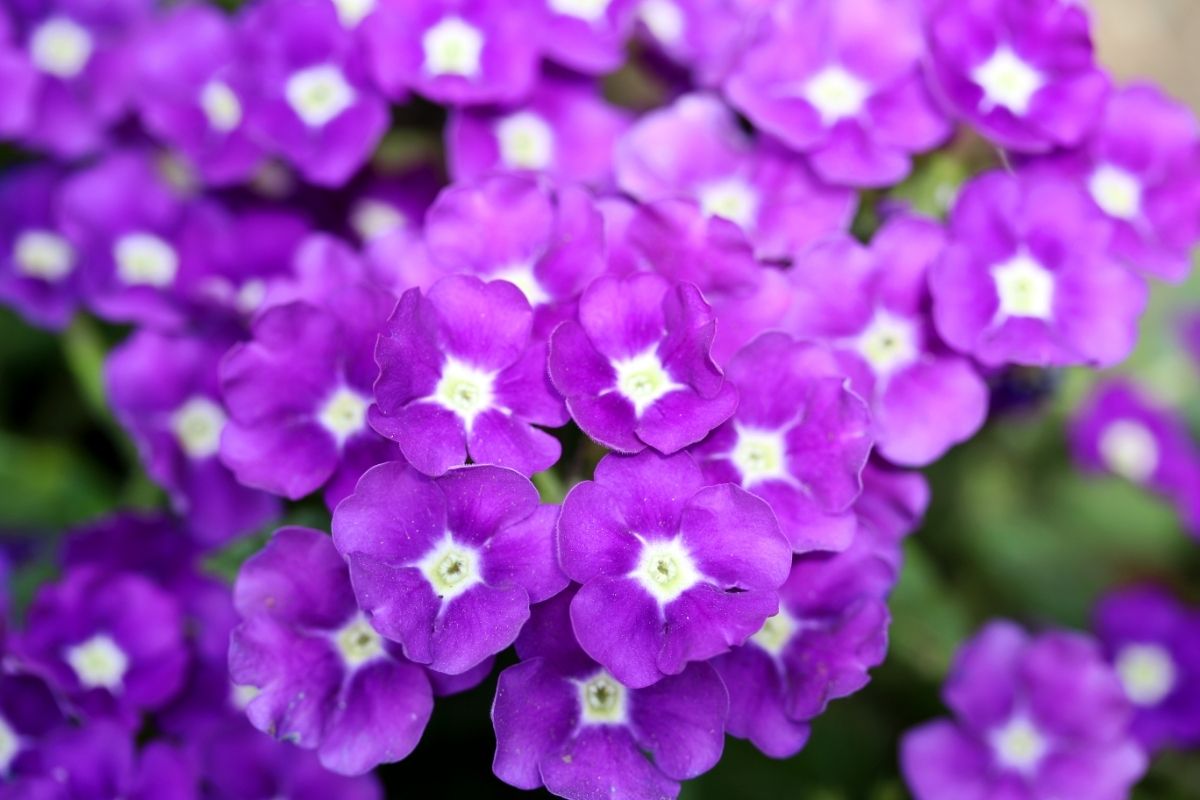
RELATED: 65 Stunning Purple Flowers of Different Types (Including Pictures)
Verbena is a genus of around 150 flowering species, each with its own coloration and structure. The Empress’s purple variety is particularly beautiful for its dark purple flowers that bear a white center, creating a stark contrast between the light and dark shades.
This is a trailing variety that has larger leaves than most other verbena species.
Empress purple verbenas are easy to grow and maintain. These flowers are quite resistant to frost, and they like to grow in full sun and well-drained soil.
9. Lisianthus (Eustoma Russellianum)

Also known as the prairie gentian or Texas bluebell, Eustoma Russellianum is a gentian species found in the Great Plains of North America.
These flowers are highly popular and are frequently picked in the wild for their stunning natural beauty, which is, unfortunately, the reason why the wild figures are dwindling.
The lisianthus produces funnel-shaped flowers (both double and single flowers) in a dark purple color.
The funnel-shaped structure makes the flowers appear like they’re swirling gracefully, making for an elegant and regal addition to a garden.
10. China Aster (Callistephus)
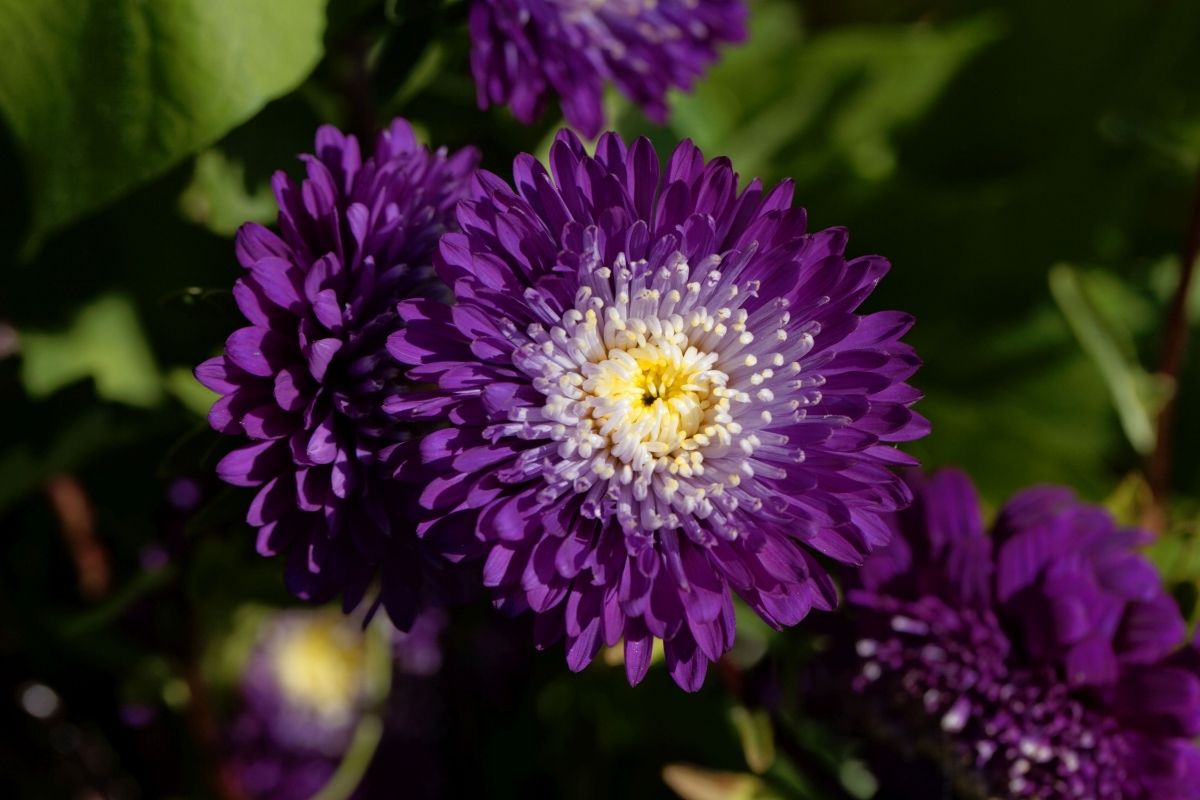
Native to China and Korea, the China aster is a genus of flowering plants most commonly cultivated as a cut flower in floral arrangements or as an ornamental plant.
These attractive annuals or biennials produce a flower on singular erect stems, wherein the daisy-like or chrysanthemum-like flower appears in varying shades of purple.
The China aster blooms in summer and stands out as a powerful dark purple flower amongst a bed of brighter blooms. While hardy, these flowers are quite difficult to grow due to specific care requirements.
11. Zinnia

Zinnia is a popular genus of flowering plants in the sunflower family. These flowers are native to southern North America and South America and are found in an array of gardens thanks to the variety of blooms on offer depending on the species.
Zinnias most commonly come in purple and pink shades, including stunning dark purple varieties.
The dark purple varieties are full of flowers in a dome-like shape.
They like to grow in full sun and will bloom in summer to fall.
12. Calla Lily
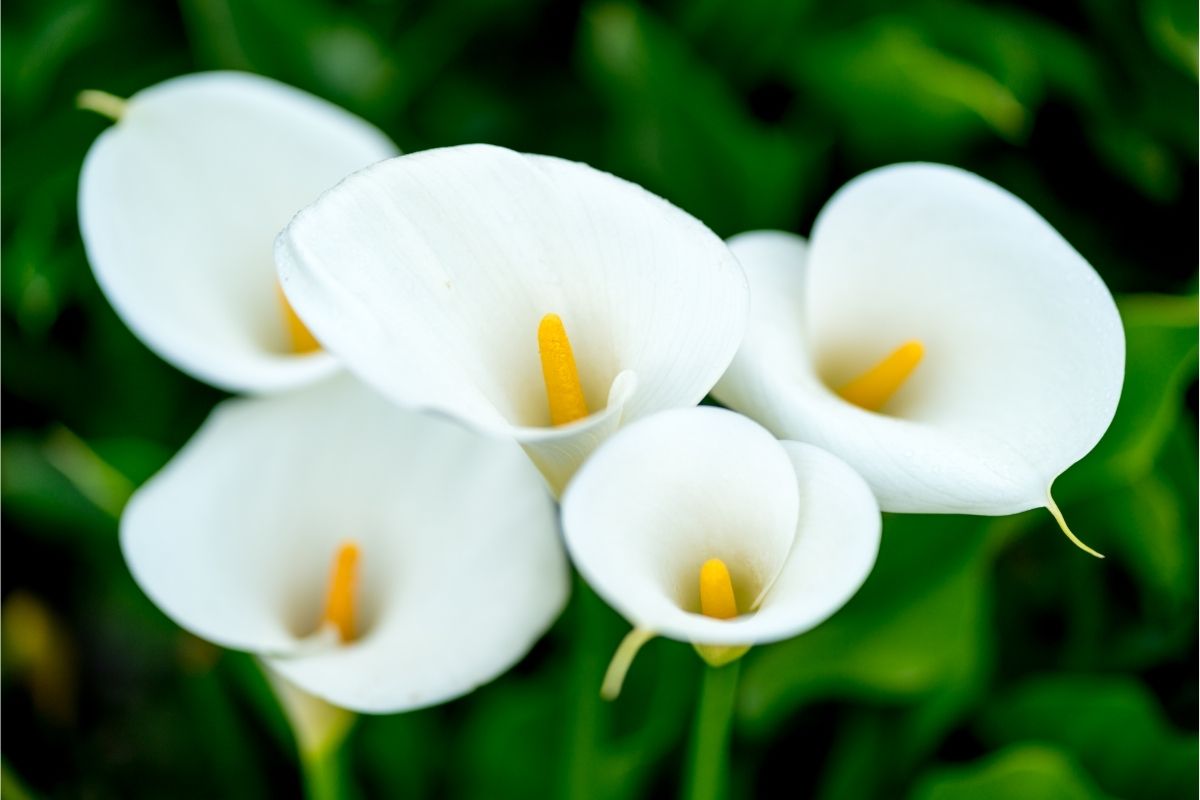
Calla lilies are a popular ornamental plant for their fascinating structures.
These exotic blooms are made up of a singular thick petal that wraps around itself into a trumpet-like shape, with a long yellow stamen protruding from the middle.
These perennials come in several colors, with the most popular being white or dark purple.
Calla lilies are easy to grow and can be planted in a garden or cut in a floral arrangement, which is why they frequently appear in bridal bouquets.
They prefer to grow in full or partial sunlight and well-drained soil.
13. Bellflower (Campanula)
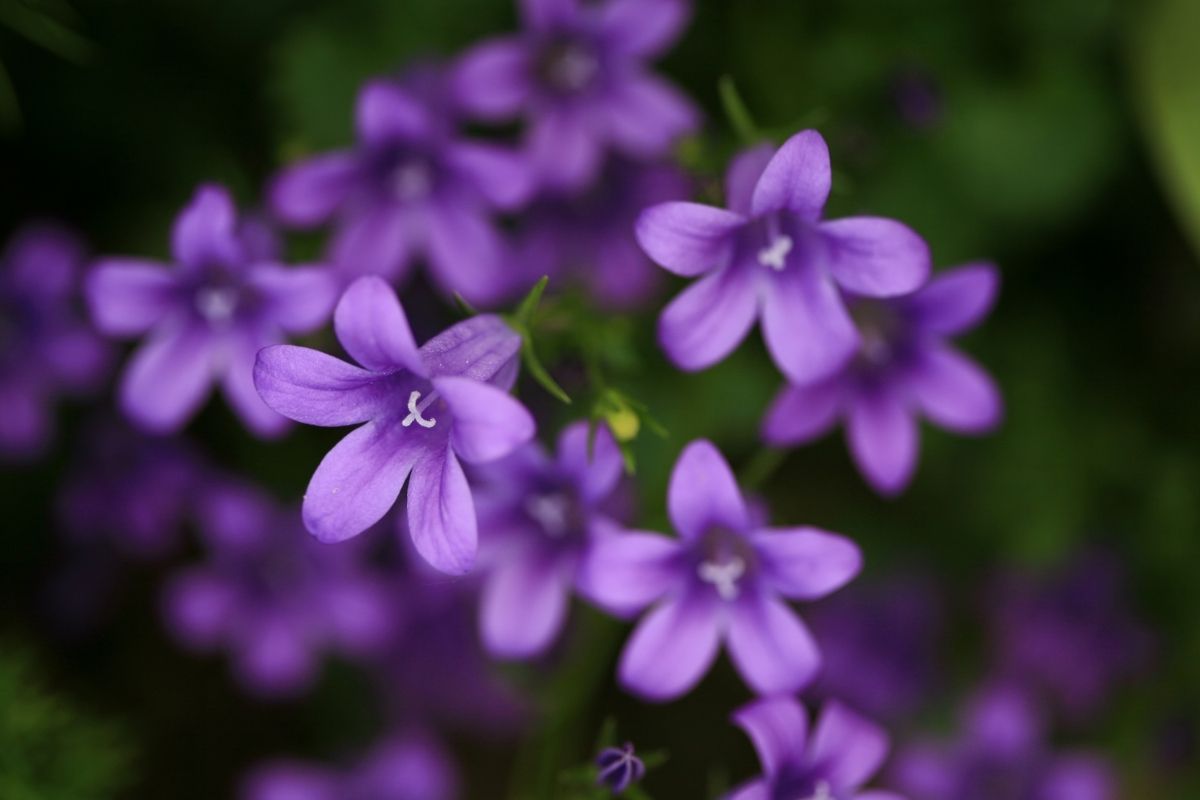
Bellflowers are a popular garden flower commonly grown in borders, rockeries, and pots. As the name suggests, these plants produce bell-shaped flowers that are typically in varying shades of purple.
While the dark purple variety might be harder to find than the violet ones, it’s certainly worth the time trying to source them.
Campanula flowers are easy to grow as they can adapt to various environments, though they typically prefer well-draining soils and partial sun.
However, they don’t enjoy the winter months, wherein they prefer to be taken inside.
14. Sword-Lily (Gladiolus ‘Purple Flora’)

The sword-lily is a towering and elegant flower that works to create a magnificent contrast in height and color to a garden. Growing up to 4-5 feet tall, they are best planted towards the back of a flower bed.
Along these erect spikes are clusters of dark purple ruffled blossoms alongside the namesake sword-like leaves.
As they are native to tropical Africa, South Africa, the Mediterranean, and Asia, sword-lilies typically prefer to grow in full sun and moist, well-drained soil.
They will flower for around 2 weeks.
15. Crocus

Crocus is a genus of about 100 species of flowering plants native across the Northern Hemisphere except for North America.
The flowers bloom from fall to winter (and sometimes through to spring), producing delicate cup-shaped blooms in varying colors, including dark purple.
As low-growers, crocus flowers are best grown at the edges of borders or at the front of hanging baskets.
Conclusion
So, there you have it!
Hopefully, this list has helped you find out the name of that dark purple flower in your garden, or it’s taught you more about the wonders of the natural flower world.
Editor’s Recommendations
What Type of Pothos Do I Have? Let Us Solve the Puzzle!
14+ Best Plants for South Window – VIP’s of the Blazing Sun
16 Best West-Facing Window Plants – Afternoon Sun Loving Beauties







